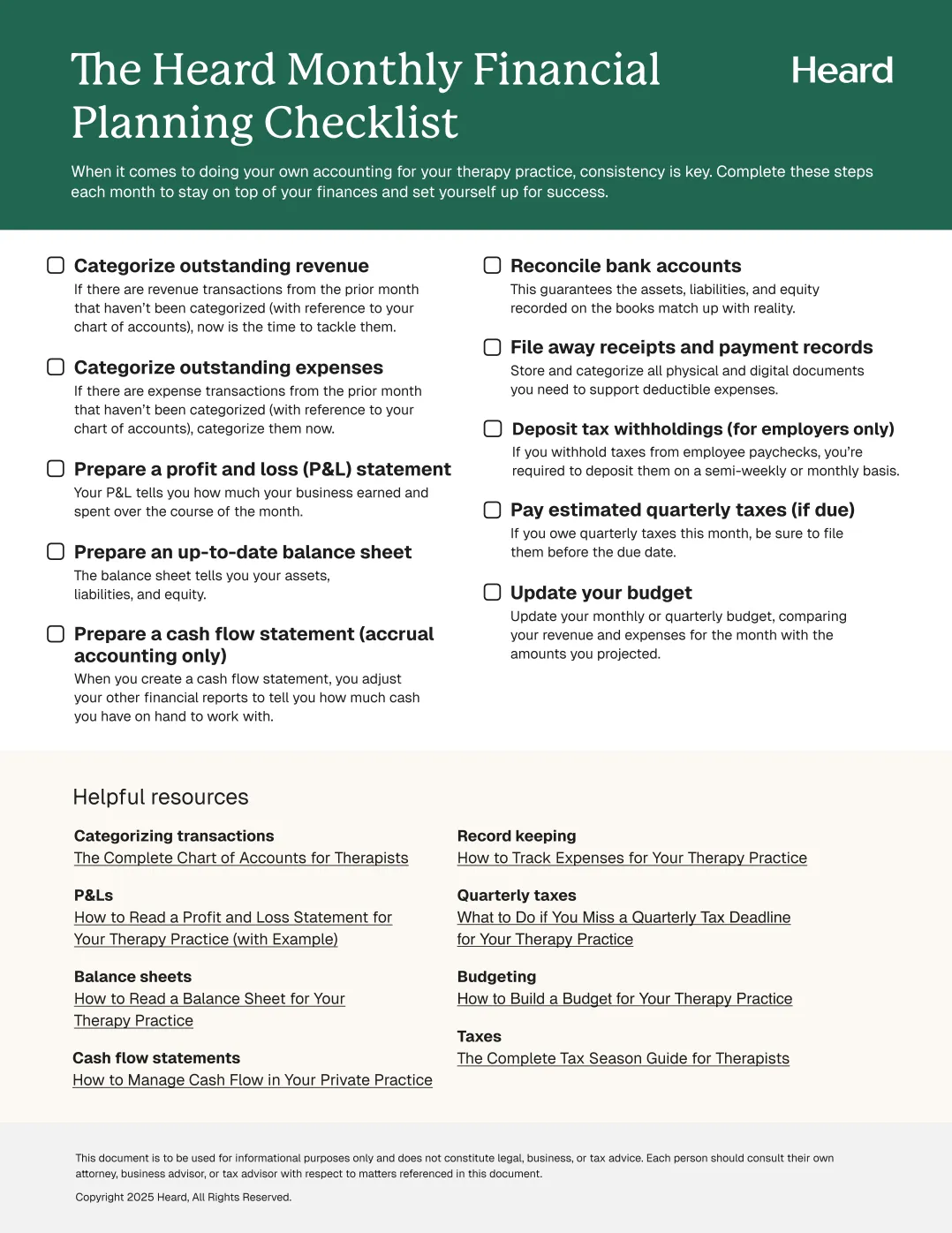When you think about the future of your therapy practice, you may look at growth over the next five years. If you have a long-term mindset, you may even look 10 years or more.
But how your progress impacts your personal finances may be less obvious. Financial planning offers therapists the ability to place your business within your entire financial picture.
By doing so, this can allow you to maximize your business and personal financial wealth or goals. Not only that, but it can also provide you with the chance to narrow in on what matters for you––and develop a game plan for how to achieve it. This creates space to enjoy the fruits of your practice, since you begin to see tangible results from your growth.
There are differences between financial planning, tax services, and bookkeeping. Below, we detail the different aspects of financial planning, to help you understand how it can boost your financial picture, along with your business. With that in place, you can better serve your clients or team.
{{resource}}
Recognizing the why behind what you do
How often do you take the opportunity to sit back and think about what you want to do in your life? What experiences do you want to have? Or what will you and your partner do when you’re no longer working every day of the week?
While therapists may be better than most in trying to be mindful of the things they do, it’s also still rare for someone to have a chance to define exactly what their future looks like. Financial planning provides this space. Why? Because you cannot plan without a goal in mind. That’s also the value of goal setting, which is instrumental in the financial planning process.
But not all goals are made the same. You may have heard of different ways to set goals, but when it comes to finances, the SMART process tends to work best. A SMART goal is:
- Specific
- Measurable
- Achievable
- Realistic
- Time-bound
Setting a financial goal that has all of these attributes gives you the ability to have something to strive for and know whether you’re reaching it. An example might be, “I want to buy a $350,000 house within three years, with a 20% down payment.” Assuming the person makes a living that’s reasonable for a $350,000 house, then that’s a fine goal.
In financial planning, we’re putting numbers to the end goal. But the numbers only support the life you want to live. It can be, “I want to save $20,000 so my partner and I can go on a dream trip to Italy within 10 years.” Again, it’s measurable, specific, and it relates to a life goal. The numbers simply support the experience.
With these goals set, we can then take steps to ensure your entire financial picture is secure, safe, and working to help you reach the future you imagine for yourself.
Where’s the money going?
When it comes to money, there’s a lot of shame and fear of embarrassment. You very well might see this in your own therapy practice. Where a financial planner often experiences it is when we discuss cash flow.
Here is where the hesitation around what a client spends money on, how much they have compared to their friends or peer groups, and their own fear of judgment from me comes into play.
But that’s not how financial planning and cash flow analysis works.
Instead, the reason cash flow analysis is done is to understand not only where the money comes from, but where it goes. This allows us to determine what funds are available to reach the goals that you have.
It’s not to shame someone for buying a latte or whatever your personal habit is. But we show what you spend money on, the impact of the spending, and what you need to reach the goals you set for yourself.
Despite this, there are some important rules of thumb that we tend to focus on in this process.
First, we’re always looking to build an emergency fund. This is to ensure that you do not have to go into debt, when the unexpected arises. For the therapy practice owner, this includes having three-to-six months of business expenses covered in the business account and having three-to-six months of expenses in the personal account. You, after all, don’t want the business to suffer simply because you need repairs to your roof, for example.
Second, we take a look at your debt. There’s good debt and bad. The good helps you grow in your business or personal life, and it’s attached to a reasonable interest rate–like a mortgage when buying a house. Bad debt, like credit card balances, can sink goals fast. We want to build a plan for all the debt, to ensure it’s not preventing you from other aspects of life.
And, of course, we also look at the funds coming in. We want to position the use of those funds so you keep more that you make and ensure that they’re funneling towards the tools that will help you live your best life.
Setting the business up for success
How your company operates and the tactics you take to run the practice will have a direct impact on your personal financial picture. The more you can save in taxes, the more you’ll have to use within the business or for personal purposes. The less you spend within the business, again, the more you can use for your own consumption.
Taking a broad look at the business and ensuring it’s set up for success from a tax and cash flow perspective is a key part of financial planning. Within this, there are two common areas that financial planners must evaluate.
Does your business structure make sense?
While you might know that many small businesses use limited liability company (LLC) status, you may not know what that means. On the other hand, you may be weighing between the LLC, the professional limited liability company (PLLC), or an S corp. Some may even be considering a C corp designation. What you choose will have a direct impact in how you pay taxes on revenues the business brings in. Financial planning involves ensuring you have the structure that makes sense for you, both now and in the future.
Does your business spending make sense?
One of the most common mistakes self-employed or small business owners make is overspending within the business account. They might say, “I’ll just write the expense off on taxes.” Remember that by writing off on taxes, you’re not getting a tax rebate. It’s not a free lunch. Instead, it’s like getting a 25% discount at the grocery store. Overspending on business expenses is one of the most common reasons I see practice owners get into debt. It’s why we look at the business side, to help provide an understanding of the overall spending picture.
Once we have a clear grasp of the spending and business, we can then begin building a plan for the rest of your finances.
{{resource}}
Why investments matter–it’s not the reason you think
When people come to a financial planner, they may have some misconceptions about the investing aspect of the process. This isn’t their fault. For years, and to this day, many investment managers claim to do financial planning only as a tool to secure investment funds.
But when it comes to investments from a financial planning perspective, it’s taking a look at your portfolio in a way you may not have heard before. Instead of focusing on gains, returns, and losses, what financial planners hone in on is your risk tolerance and time horizon. These two measures tell us how much risk you’re willing to take and when you will need the investments, like for retirement.
By looking at these measures, we can build portfolios that match your risk preference and time horizon. We don’t want you changing your investment strategy every time the market drops 10% and there’s little point in having a large bond exposure when you have 30 years of investing in front of you, as examples.
This analysis places your investments within your entire financial picture––along with your business, home, and other assets––allowing you to take only the necessary risk that you can stomach to reach the goals you aim for.
Optimizing taxes throughout your life
When working with tax planners, like Heard, there’s a heavy focus on planning for taxes through the year. It’s a vital process to protect finances today.
But you also need to take into account taxes throughout your entire life. That’s how financial planning tax analysis differs. It’s figuring out the best way to save, spend, or position yourself to ensure you pay taxes in the most advantageous way at every stage of life.
While you might assume this means avoiding taxes, it does not. Everyone must pay taxes, but there are ways to coordinate it so you’re paying the IRS at the most optimal time. For instance, you may have a 401(k) through your practice. And you might also have an Individual Retirement Account (IRA). A financial planner will look at the resources in the accounts, along with expected funds moving forward, to determine when to pay taxes on the investments.
Maybe, one of the best moves a person can make is to slowly transition the funds in the 401(k) to a Roth 401(k). In 401(k) accounts, you’re taxed on the funds when you withdraw them. In a Roth 401(k), you’re taxed when you fund the account, but not taxed on any of the returns after that point. In some cases, it may be better for you to pay taxes today so you’re not paying them in the future. In other cases, that’s not true.
The financial planning process will determine the best tax strategy, whether it’s in your investment accounts, or other parts of your life, like your business, home, or other assets.
{{resource}}
Looking out for the future you
What the future goals of one person looks like will differ greatly from another. But whether you want to retire at the beach by 55 or plan to work until you cannot any longer, using retirement tools to save funds can put your financial picture in a stronger place. While you may want to work forever, you do not want to be forced to work forever. Retirement planning ensures you do not have to.
This also allows you to take more risk in your business, if you have a large amount of savings in a 401(k) or other retirement vehicle. It provides protection.
But it’s also a fantastic tax-cutting tool. Utilizing tax advantaged accounts, like a Roth IRA, tax deferred accounts, like a 401(k) or IRA, or even a brokerage account, you can determine when the best time to pay taxes on the savings is – today, when you distribute funds later in life, or possibly never.
In financial planning, we take all of these accounts into consideration to figure out when you’ve reached financial independence or the point where you no longer have to work. Then, depending on your goals, we plan for when you are ready to spend down the support you built.
Protecting all of you
Insurance is a tool to transfer risk. We use insurance to transfer very large risks to the insurance company. We pay for that transfer of risk in the form of a premium.
While insurance can have a bad rap, in financial planning we look at the risks that could derail a person’s financial situation. For a young family with a child that wants to support their kid, put her through college and keep her safe, buying term life insurance is important to protect against the risk that one of the parents could pass away.
Some financial planners sell insurance, as well as recommend it. Instead, look for fee-only planners, so you know they’re not getting a commission for selling you insurance. The only person paying fee-only planners for advice they give you, is you. Then, if they’re suggesting insurance, it’s only to protect you from risks that would derail your goals.
For therapists in private practice, we would also look at the long-term disability insurance that’s in place. It’s far more likely you will suffer a long-term disability, derailing your ability to work, than it is for you to pass away during your career. Long-term disability is vital to protect against that possibility.
Planning for when you’re gone
Financial planning goes further than most other financial analyses, not just due to the scope, but also because it evaluates your assets for when you’re no longer here.
Through trusts, wills, power of attorneys and other tools, financial plans will look at where your assets will go when you’re gone, who will manage your accounts, and through what process. The goal? To have as easy of a transition of assets to your heirs as possible, while reducing any exposure to potential taxes.
For therapists in particular, one forgotten tool is the business succession plan. In other words, developing a plan for the business that you spent a lifetime building, for when you’re ready to step away from the chair.
It’s not true that the business will die without you––and finding ways to position it for a sale in the years before you’re ready to quit is important for your financial picture and long-term goals.
These succession plans can also kick in through buy-sell or cross-purchase agreements with partners if you were to pass away. This allows you to negotiate the sale of the business today, while healthy, allowing for the business to pass hands when you’re gone. Meanwhile, your family retains the value of the business through the sale.
–
This post is to be used for informational purposes only and does not constitute legal, business, or tax advice. Each person should consult their own attorney, business advisor, or tax advisor with respect to matters referenced in this post.
Ryan Derousseau, CFP®, is a fee-only financial advisor at United Financial Planning Group, where he specializes in working with therapists, private and group practitioners, and the self-employed, enabling them to thrive financially so they can focus on clients. You can join the Private Practice Owners Skool community, where he provides courses and financial guidance, or contact him directly via his website www.ThinkingCapFinancial.com.
{{cta}}
Manage your bookkeeping, taxes, and payroll—all in one place.

Discover more. Get our newsletter.
Get free articles, guides, and tools developed by our experts to help you understand and manage your private practice finances.





